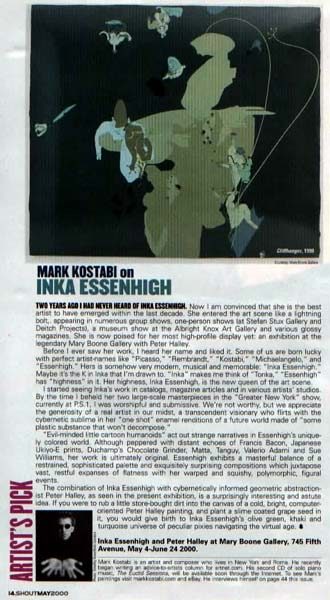Mark Kostabi on Inka Essenhigh

Two years ago I had never heard of Inka Essenhigh. Now I am convinced that she is the best artist to have emerged within the last decade. She entered the art scene like a lightning bolt, appearing in numerous group shows, one-person shows (at Stefan Stux Gallery and Deitch Projects), a museum show at the Albright Knox Art Gallery and various glossy magazines. She is now poised for her most high-profile display yet: an exhibition at the legendary Mary Boone Gallery with Peter Halley.
Before I ever saw her work, I heard her name and liked it. Some of us are born lucky with perfect artist-names like “Picasso,” “Rembrandt,” “Kostabi,” “Michelangelo,” and “Essenhigh.” Hers is somehow very modern, musical and memorable: “Inka Essenhigh.” Maybe it’s the K in Inka that I’m drawn to. “Inka” makes me think of “Tonka,” “Essenhigh” has “highness” in it. Her highness, Inka Essenhigh, is the new queen of the art scene.
I started seeing Inka’s work in catalogs, magazine articles and in various artists’ studios. By the time I beheld her two large-scale masterpieces in the “Greater New York” show, currently at P.S.1, I was worshipful and submissive. We’re not worthy, but we appreciate the generosity of a real artist in our midst, a transcendent visionary who flirts with the cybernetic sublime in her “one shot” enamel renditions of a future world made of “some plastic substance that won’t decompose.”
“Evil-minded little cartoon humanoids” act out strange narratives in Essenhigh’s uniquely colored world. Although peppered with distant echoes of Francis Bacon, Japanese Ukiyo-E prints, Duchamp’s Chocolate Grinder, Matta, Tanguy, Valerio Adami and Sue Williams, her work is ultimately original. Essenhigh exhibits a masterful balance of a restrained, sophisticated palette and exquisitely surprising compositions which juxtapose vast, restful expanses of flatness with her warped and squishy, polymorphic, figural events.
The combination of Inka Essenhigh with cybernetically informed geometric abstractionist Peter Halley, as seen in the present exhibition, is a surprisingly interesting and astute idea. If you were to rub a little store-bought dirt into the canvas of a cold, bright, computer-oriented Peter Halley painting, and plant a slime coated grape seed in it, you would give birth to Inka Essenhigh’s olive green, khaki and turquoise universe of peculiar pixies navigating the virtual age.
May 2000